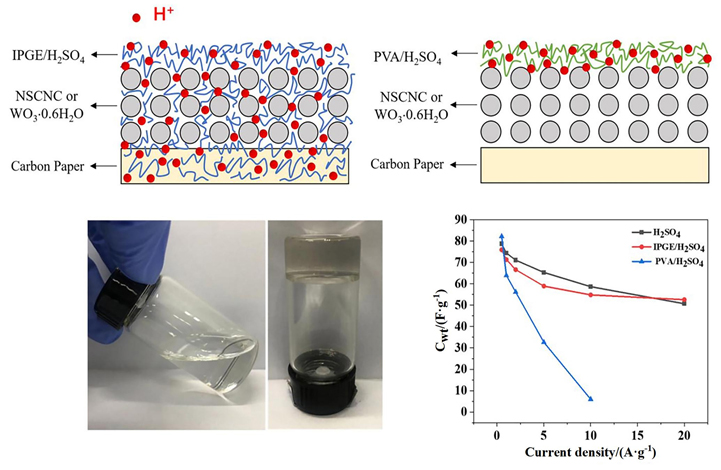| [1] |
Raza, W.; Ali, F. Z.; Raza, N.; Luo, Y. W.; Kim, K. H.; Yang, J. H.; Kumar, S.; Mehmood, A.; Kwon, E. E. Nano Energy 2018, 52, 441.
doi: 10.1016/j.nanoen.2018.08.013
|
| [2] |
Su, S. J.; Lai, Q. X.; Liang, Y. Y. Acta Chim. Sinica 2015, 73, 735.
doi: 10.6023/A15030207
|
|
(苏善金, 来庆学, 梁彦瑜, 化学学报, 2015, 73, 735.)
doi: 10.6023/A15030207
|
| [3] |
Muzaffar, A.; Ahamed, M. B.; Deshmukh, K.; Thirumalai, J. Renew. Sust. Energy Rev. 2019, 101, 123.
doi: 10.1016/j.rser.2018.10.026
|
| [4] |
Zhu, J.; Tang, S. C.; Wu, J.; Shi, X. L.; Zhu, B. G.; Meng, X. K. Adv. Energy Mater. 2017, 7, 1601234.
doi: 10.1002/aenm.201601234
|
| [5] |
Couly, C.; Alhabeb, M.; Van Aken, K. L.; Kurra, N.; Gomes, L.; Navarro-Suarez, A. M.; Anasori, B.; Alshareef, H. N.; Gogotsi, Y. Adv. Electron. Mater. 2018, 4, 1700339.
doi: 10.1002/aelm.v4.1
|
| [6] |
Zhao, J.; Andrew, F. B. Energy Storage Mater. 2021, 36, 31.
|
| [7] |
Shao, Y.; El-Kady, M. F.; Sun, J.; Li, Y.; Zhang, Q.; Zhu, M.; Wang, H.; Dunn, B.; Kaner, R. B. Chem. Rev. 2018, 118, 9233.
doi: 10.1021/acs.chemrev.8b00252
|
| [8] |
Wu, Q.; Yang, L.; Wang, X.; Hu, Z. Adv. Mater. 2020, 32, 1904177.
|
| [9] |
Yang, L. J.; Shui, J. L.; Du, L.; Shao, Y. Y.; Liu, J.; Dai, L. M.; Hu, Z. Adv. Mater. 2019, 31, 1804799.
doi: 10.1002/adma.v31.13
|
| [10] |
Wu, Q.; Yang, L.; Wang, X.; Hu, Z. Sci. China Chem. 2020, 63, 665.
doi: 10.1007/s11426-020-9748-0
|
| [11] |
Wu, Q.; Yang, L.; Wang, X.; Hu, Z. Acc. Chem. Res. 2017, 50, 435.
doi: 10.1021/acs.accounts.6b00541
|
| [12] |
Li, G.; Mao, K.; Liu, M.; Yan, M.; Zhao, J.; Zeng, Y.; Yang, L.; Wu, Q.; Wang, X.; Hu, Z. Adv. Mater. 2020, 32, 2004632.
doi: 10.1002/adma.v32.52
|
| [13] |
Zhao, J.; Lai, H.; Lyu, Z.; Jiang, Y.; Xie, K.; Wang, X.; Wu, Q.; Yang, L.; Jin, Z.; Ma, Y.; Liu, J.; Hu, Z. Adv. Mater. 2015, 27, 3541.
doi: 10.1002/adma.v27.23
|
| [14] |
Xie, K.; Qin, X.; Wang, X.; Wang, Y.; Tao, H.; Wu, Q.; Yang, L.; Hu, Z. Adv. Mater. 2012, 24, 347.
doi: 10.1002/adma.201103872
|
| [15] |
Jiang, H.; Hong, J. J.; Wu, X.; Surta, T. W.; Qi, Y.; Dong, S.; Li, Z.; Leonard, D. P.; Holoubek, J. J.; Wong, J. C.; Razink, J. J.; Zhang, X.; Ji, X. J. Am. Chem. Soc. 2018, 140, 11556.
doi: 10.1021/jacs.8b03959
|
| [16] |
Anothumakkool, B.; Torris, A. A. T.; Veeliyath, S.; Vijayakumar, V.; Badiger, M. V.; Kurungot, S. ACS Appl. Mater. Interfaces 2016, 8, 1233.
doi: 10.1021/acsami.5b09677
|
| [17] |
Lu, X. H.; Yu, M. H.; Wang, G. M.; Tong, Y. X.; Li, Y. Energy Environ. Sci. 2014, 7, 2160.
doi: 10.1039/c4ee00960f
|
| [18] |
Wang, F. X.; Wu, X. W.; Yuan, X. H.; Liu, Z. C.; Zhang, Y.; Fu, L. J.; Zhu, Y. S.; Zhou, Q. M.; Wu, Y. P.; Huang, W. Chem. Soc. Rev. 2017, 46, 6816.
doi: 10.1039/C7CS00205J
|
| [19] |
Zhu, M.; Wu, J. X.; Wang, Y.; Song, M. M.; Long, L.; Siyal, S. H.; Yang, X. P.; Sui, G. J. Energy Chem. 2019, 37, 126.
doi: 10.1016/j.jechem.2018.12.013
|
| [20] |
Anothumakkool, B.; Torris, A. A. T.; Bhange, S. N.; Unni, S. M.; Badiger, M. V.; Kurungot, S. ACS Appl. Mater. Interfaces 2013, 5, 13397.
doi: 10.1021/am404320e
|
| [21] |
Niu, Y. B.; Yin, Y. X.; Wang, W. P.; Wang, P. F.; Guo, Y. G. CCS Chem. 2019, 1, 589.
|
| [22] |
Fan, H.; Wang, Y.; Gao, F.; Yang, L.; Liu, M.; Du, X.; Wang, P.; Yang, L.; Wu, Q.; Wang, X.; Hu, Z. J. Energy Chem. 2019, 34, 64.
doi: 10.1016/j.jechem.2018.09.003
|
| [23] |
Augustyn, V.; Simon, P.; Dunn, B. Energy Environ. Sci. 2014, 7, 1597.
doi: 10.1039/c3ee44164d
|
| [24] |
Lu, S. Y.; Jin, M.; Zhang, Y.; Niu, Y. B.; Gao, J. C.; Li, C. M. Adv. Energy Mater. 2018, 8, 1702545.
doi: 10.1002/aenm.201702545
|
| [25] |
Luo, J.; Jang, H. D.; Huang, J. ACS Nano 2013, 7, 1464.
doi: 10.1021/nn3052378
|
| [26] |
Yan, J.; Fan, Z.; Sun, W.; Ning, G.; Wei, T.; Zhang, Q.; Zhang, R.; Zhi, L.; Wei, F. Adv. Funct. Mater. 2012, 22, 2632.
doi: 10.1002/adfm.201102839
|
| [27] |
Zhang, S. W.; Yin, B. S.; Wang, Z. B.; Peter, F. Chem. Eng. J. 2016, 306, 193.
doi: 10.1016/j.cej.2016.07.057
|
| [28] |
Subramani, K.; Sudhan, N.; Divya, R.; Sathish, M. RSC Adv. 2017, 7, 6648.
doi: 10.1039/C6RA27331A
|
| [29] |
Wang, C. Q.; Qiu, F. L.; Deng, H.; Zhang, X. Y.; He, P.; Zhou, H. S. Acta Chim. Sinica 2017, 75, 241.
doi: 10.6023/A16100523
|
|
(王超强, 邱飞龙, 邓瀚, 张晓禹, 何平, 周豪慎, 化学学报, 2017, 75, 241.)
doi: 10.6023/A16100523
|
| [30] |
Fan, H. L.; Niu, R. T.; Duan, J. Q.; Liu, W.; Shen, W. Z. ACS Appl. Mater. Interfaces 2016, 8, 19475.
doi: 10.1021/acsami.6b05415
|
| [31] |
Liu, W. W.; Li, X.; Zhu, M. H.; He, X. J. Power Sources 2015, 282, 179.
doi: 10.1016/j.jpowsour.2015.02.047
|
| [32] |
Lai, H.; Wu, Q.; Zhao, J.; Shang, L.; Li, H.; Che, R.; Lyu, Z.; Xiong, J.; Yang, L.; Wang, X. Energy Environ. Sci. 2016, 9, 2053.
doi: 10.1039/C6EE00603E
|
| [33] |
Gao, D.; Liu, R.; Yu, W.; Luo, Z.; Liu, C.; Fan, S. J. Phys. Chem. C 2019, 123, 5249.
doi: 10.1021/acs.jpcc.8b11644
|
 ), 杨立军, 王喜章, 胡征
), 杨立军, 王喜章, 胡征
 ), Lijun Yang, Xizhang Wang, Zheng Hu
), Lijun Yang, Xizhang Wang, Zheng Hu
